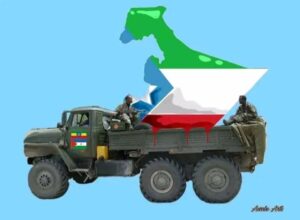A dangerous new political and economic maneuver is unfolding in Ethiopia. Under the leadership of Prime Minister Abiy Ahmed, the federal government is quietly advancing a plan that seeks to absorb parts of the Somali Region’s resource-rich territories into Oromia. This campaign—combining territorial expansion, military occupation, and political manipulation—poses an existential threat to the Somali people’s constitutional rights and regional autonomy.
Step 1: Territorial Annexation Under Development Disguise
The first stage of this project involves redrawing administrative boundaries to gradually incorporate Somali territories into Oromia. This process is being carried out through road construction, infrastructure projects, and selective demographic shifts framed as “development initiatives.”
- The Godey Corridor: New roads are being constructed to connect Oromia’s Bale Zone and Gindhir Town directly with Godey City, a strategic hub for Ethiopia’s natural gas deposits. Portions of Godey are reportedly being administratively absorbed into Oromia—a move that undermines the Somali Region’s jurisdiction.
- East and West Imey Districts: Once integral parts of the Somali Region’s Afdar Zone, these areas are being transferred to Oromia’s Rasa administrative structure, forcing the displacement of Somali pastoral communities.
These actions amount to a slow, deliberate annexation—a redrawing of Ethiopia’s internal borders without constitutional or parliamentary approval.
Step 2: Militarization and Ethnic Targeting
The Ethiopian National Defense Force (ENDF) has become a key instrument in this campaign, consolidating federal control and suppressing local resistance.
- Godey Military Camp: A massive new base has been established near the gas fields, extending federal presence deeper into Somali territory.
- Land Confiscation: ENDF Commander General Birhanu Jula confirmed the seizure of 150 km² of land for “military-commercial farming” operations. The move was reportedly approved by Somali regional president Mustafa Mohumed Omar, raising serious questions about collaboration in unlawful land transfers.
- Targeted Violence:
- In the 2021 Garba-Issa massacre, more than 400 Somali civilians were killed by Afar militias supported by federal troops.
- Recent reports from Qabridahare, Aysha, and Jigjiga Airport detail assassinations, extrajudicial killings, and arbitrary detentions of Somali civilians and officials.
With no Somali officers holding senior command positions in the ENDF, the army is increasingly viewed as an occupying force, facilitating demographic change by settling non-Somali families in confiscated areas.
Step 3: Political Co-optation and Deception
To mask these activities, the government has employed a combination of false promises and political co-optation to silence opposition from within the Somali Region.
- The 50% Revenue Myth: In 2019, Abiy Ahmed publicly promised that the Somali Region would receive half of all natural gas revenues. The pledge has never been enacted, and no formal revenue-sharing framework exists.
- Installed Proxies: Figures such as Saharla Abdilahi, head of Ethiopia’s Petroleum Agency and a member of the Somali Prosperity Party (PP), have been strategically positioned to legitimize federal exploitation while deflecting local criticism.
- Controlled Narrative: Regional media and administration have been pressured to frame these developments as “federal integration” or “national resource management,” obscuring their constitutional violations.
This systematic co-optation ensures that regional leaders echo federal rhetoric while the Somali people remain excluded from decision-making over their own land and resources.
A Threat to Ethiopia’s Federal Integrity
The Ethiopian Constitution guarantees regional autonomy and ownership of local natural resources. However, the ongoing actions in the Somali Region represent a direct violation of these principles. The “Oromization” of the Somali gas belt is not only an assault on Somali sovereignty but also a dangerous precedent for Ethiopia’s fragile multinational federation.
If left unchecked, this policy could ignite widespread inter-regional conflict, destabilizing both the Somali and Oromia regions and threatening the entire Horn of Africa’s security.
Call for Accountability and International Oversight
SittiSomali calls upon:
- The African Union, United Nations, and European Union to investigate territorial violations and resource exploitation in the Somali Region.
- Human rights organizations to document and expose the pattern of militarization and ethnic targeting.
- Ethiopia’s federal parliament and judiciary to uphold the Constitution and halt unlawful border adjustments.
The Somali Region’s natural wealth should be a foundation for prosperity and unity—not a trigger for marginalization and dispossession.

